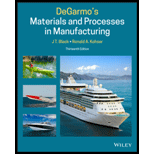
Degarmo's Materials And Processes In Manufacturing
13th Edition
ISBN: 9781119492825
Author: Black, J. Temple, Kohser, Ronald A., Author.
Publisher: Wiley,
expand_more
expand_more
format_list_bulleted
Concept explainers
Textbook Question
Chapter 2, Problem 2RQ
Provide two definitions of the term manufacturing.
Expert Solution & Answer
Want to see the full answer?
Check out a sample textbook solution
Students have asked these similar questions
Question: Define and explain the following:
(a) Types of manufacturing systems including flexible automation
(b) Storage systems including storage buffer
Note: This question is taken from the Production Automation Course.
Explain the following with reference to their flexibility and productivity in manufacturing systems and elaborate with examples:i. Transfer Lineii. Dedicated Systemiii. Flexible Manufacturing Systemiv. Manufacturing Cellv. Stand Alone CNC
manufacturing technologhy
please answer as sooon as possibble
Chapter 2 Solutions
Degarmo's Materials And Processes In Manufacturing
Ch. 2 - Prob. 1RQCh. 2 - Provide two definitions of the termÂ...Ch. 2 - Knowledge of what four aspects and their...Ch. 2 - Give an example of how we might take advantage of...Ch. 2 - What are some of the possible property...Ch. 2 - What are some properties commonly associated with...Ch. 2 - What are some of the more common nonmetallic...Ch. 2 - What are some of the important physical properties...Ch. 2 - Why should caution be exercised when applying the...Ch. 2 - What are the standard units used to report stress...
Ch. 2 - What are static properties?Ch. 2 - What is the most common static test to determine...Ch. 2 - What is engineering stress? Engineering strain?...Ch. 2 - What is Youngs modulus or stiffness, and why might...Ch. 2 - What are some of the tensile test properties that...Ch. 2 - Why is it important to specify the offset when...Ch. 2 - How is the offset yield strength determined?Ch. 2 - During the plastic deformation portion of a...Ch. 2 - What are the test conditions associated with...Ch. 2 - How would the tensile test curves differ for a...Ch. 2 - What are two tensile test properties that can be...Ch. 2 - What is uniform elongation, and when might it be...Ch. 2 - Is a brittle material a weak material? What does...Ch. 2 - What is the toughness of a material, and how might...Ch. 2 - What is the difference between true stress and...Ch. 2 - Explain how the plastic portion of a true...Ch. 2 - What is strain hardening or work hardening? How...Ch. 2 - Give examples of applications utilizing high...Ch. 2 - How might tensile test data be misleading for a...Ch. 2 - What type of tests can be used to determine the...Ch. 2 - What are some of the different material...Ch. 2 - What units could be applied to the Brinell...Ch. 2 - Although the Brinell hardness test is simple and...Ch. 2 - What are the similarities and differences between...Ch. 2 - Why are there different Rockwell hardness scales?Ch. 2 - How might hardness tests be used for quality...Ch. 2 - What are the attractive features of the Vickers...Ch. 2 - When might a microhardness test be preferred over...Ch. 2 - What is the attractive feature of the Knoop...Ch. 2 - Why might the various types of hardness tests fail...Ch. 2 - What is the relationship between penetration...Ch. 2 - Describe several types of dynamic loading.Ch. 2 - Why should the results of standardized dynamic...Ch. 2 - What are the two most common types of bending...Ch. 2 - What aspects or features can significantly alter...Ch. 2 - What is notch�sensitivity, and how might it be...Ch. 2 - Which type of dynamic condition accounts for...Ch. 2 - Are the stresses applied during a fatigue test...Ch. 2 - Is a fatigue S–N curve determined from a...Ch. 2 - What is the endurance limit? What occurs when...Ch. 2 - What features may significantly alter the fatigue...Ch. 2 - What relationship can be used to estimate the...Ch. 2 - Describe the growth of a fatigue crack.Ch. 2 - What material, design, or manufacturing features...Ch. 2 - How might the relative sizes of the fatigue region...Ch. 2 - What are fatigue striations, and why do they form?Ch. 2 - Why is it important for a designer or engineer to...Ch. 2 - What mechanical property changes are typically...Ch. 2 - Prob. 59RQCh. 2 - Prob. 60RQCh. 2 - How might the orientation of a piece of metal...Ch. 2 - How might we evaluate the long�term effect of...Ch. 2 - Prob. 63RQCh. 2 - What is a stress–rupture diagram, and how is one...Ch. 2 - Why are terms such as machinability, formability,...Ch. 2 - Prob. 66RQCh. 2 - What are some of the types of flaws or defects...Ch. 2 - What three principal quantities does fracture...Ch. 2 - What is a dormant flaw? A dynamic flaw? How do...Ch. 2 - How is fracture mechanics applied to fatigue...Ch. 2 - What are the three most common thermal properties...Ch. 2 - Describe an engineering application where the...Ch. 2 - Why is it important that property testing be...Ch. 2 - Why is it important to consider the orientation of...Ch. 2 - Select a product or component for which physical...Ch. 2 - Repeat Problem 1 for a product or component...Ch. 2 - Repeat Problem 1 for a product or component...Ch. 2 - A fuel tanker or railroad tanker car has been...Ch. 2 - One of the important considerations when selecting...Ch. 2 - Several of the property tests described in this...Ch. 2 - Steel and aluminum cans that have been submitted...Ch. 2 - Prob. 2CSCh. 2 - Prob. 3CSCh. 2 - Prob. 4CSCh. 2 - Prob. 5CSCh. 2 - Prob. 6CSCh. 2 - Mixed plastic consisting of recyclable...Ch. 2 - What do you suspect is the cause of these...Ch. 2 - Prob. bCSCh. 2 - Prob. cCS
Knowledge Booster
Learn more about
Need a deep-dive on the concept behind this application? Look no further. Learn more about this topic, mechanical-engineering and related others by exploring similar questions and additional content below.Similar questions
- Give the definition of the following emerged technologies, provide a sample application and illustration: Robotic Processor Automationarrow_forwardWhat is a journeyperson?arrow_forwardWith a block diagram, explain the different phase of design and manufacturing process. (b) What is meant by concurrent engineering? Describe the various schemes for concurrent engineering.arrow_forward
arrow_back_ios
SEE MORE QUESTIONS
arrow_forward_ios
Recommended textbooks for you
 Precision Machining Technology (MindTap Course Li...Mechanical EngineeringISBN:9781285444543Author:Peter J. Hoffman, Eric S. Hopewell, Brian JanesPublisher:Cengage Learning
Precision Machining Technology (MindTap Course Li...Mechanical EngineeringISBN:9781285444543Author:Peter J. Hoffman, Eric S. Hopewell, Brian JanesPublisher:Cengage Learning

Precision Machining Technology (MindTap Course Li...
Mechanical Engineering
ISBN:9781285444543
Author:Peter J. Hoffman, Eric S. Hopewell, Brian Janes
Publisher:Cengage Learning
What is Rapid Prototyping?; Author: Formlabs;https://www.youtube.com/watch?v=-TDn25K-Jh4;License: Standard youtube license